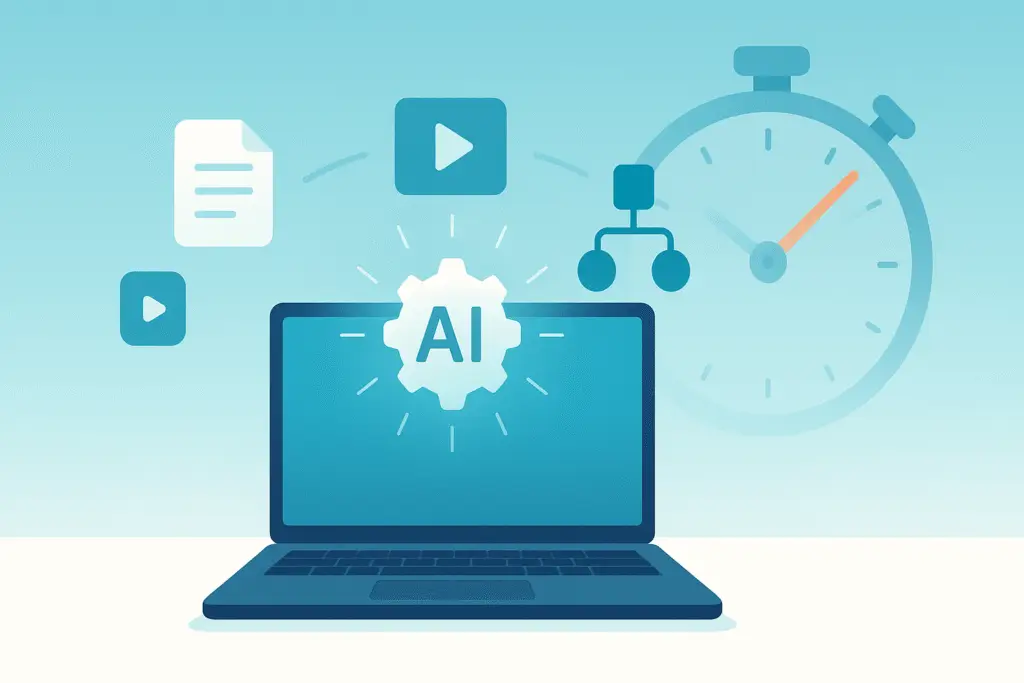You’re wasting several hours every week on tasks that AI could handle both better and faster. The problem isn’t that these tools don’t exist—it’s that most business owners don’t know about them.
Here are five AI tools that will save you significant time on content creation, document design, and business processes. These aren’t the obvious choices like ChatGPT, but specialized tools that excel at specific tasks.
Table of Contents
ToggleGamma App: Professional Documents in Minutes
Gamma eliminates the time-consuming process of formatting presentations and documents. Instead of spending hours on layout and design, you simply provide text or a prompt, and Gamma creates professional-looking slides, proposals, or documents within minutes.
The AI handles layout decisions, image selection, and design consistency automatically. You get a polished result that you can then edit as needed. The free version provides approximately 10 presentations worth of credits (400 credits total), making it generous for new users who want to test extensively.
Best for: Presentations, proposals, professional documents, and any public-facing materials that need visual appeal.
Pricing: Free tier available, $10/month for paid plans.
Descript: AI-First Video Editing
Descript transforms video editing by letting you edit footage like a text document. The AI transcribes your video, then you can cut, modify, or rearrange content by editing the transcript.
Key time-saving features include:
- Automatic filler word removal: Eliminates “um,” “uh,” and awkward pauses with one click
- Studio Sound: Removes background noise and enhances voice clarity automatically
- Instant subtitles: Auto-generates and syncs captions in seconds
- Word gap removal: Tightens speech by removing dead air between words
Instead of manually cutting out every pause and filler word, Descript’s AI handles these tedious tasks instantly. Even recordings made in noisy environments sound professional after Studio Sound processing.
Best for: Video podcasts, educational content, marketing videos, and any content requiring clean audio and professional editing.
Opus Clip vs. Descript: When to Use Each
While both tools use AI for video creation, they serve different purposes:
Use Descript when:
- You need comprehensive editing control for one main video
- Audio quality improvement is crucial
- You’re creating polished final cuts of longer content
- You need precision editing with manual adjustments
Use Opus Clip when:
- You want to turn long-form content into multiple social media clips
- You need batch processing of viral-worthy moments
- Speed matters more than detailed control
- You’re creating content for TikTok, Instagram Reels, or YouTube Shorts
Opus Clip analyzes your video to identify compelling moments, then automatically creates multiple short-form clips with captions and proper formatting. It even provides a “virality score” to predict which clips will perform best.
Many content creators use both: Descript for editing the master content, then Opus Clip for generating derivative social media clips.
Miro AI: Instant Diagrams and Flowcharts
Miro’s AI diagramming creates visual representations from text descriptions. Instead of manually drawing shapes and connectors, you describe what you want in natural language.
For example, you might prompt: “Show a flowchart of the user signup process with steps X, Y, Z and decisions A or B.” Miro generates the structured diagram within seconds.
Supported diagram types:
- Flowcharts
- Mind maps
- Organizational charts
- UML diagrams
- Process workflows
This eliminates the tedious mechanics of diagram creation, letting you focus on content rather than drawing. Teams can quickly kick off projects with auto-generated diagrams, then refine them collaboratively.
Best for: Process mapping, brainstorming sessions, project planning, and visualizing complex information.
Airtable: Bulk AI Processing
For running large volumes of text-based AI prompts simultaneously, Airtable’s AI fields provide a powerful solution.
You can set up AI-powered fields that apply custom prompts to every record in your database. This means you can:
- Generate product descriptions for an entire catalog
- Create SEO meta tags for 100 blog posts at once
- Summarize feedback from dozens of survey responses
- Analyze customer data in bulk
Each AI field can reference other data in that row for context, and Airtable processes everything in one bulk operation. You don’t need to copy-paste prompts individually or export data to external tools.
Example use case: A marketing team inputs campaign details into Airtable and uses an AI field to generate tailored social media posts for each campaign automatically.
Best for: Content generation at scale, data analysis, SEO optimization, and any repetitive text-based tasks.
@tjrobertson52 You're wasting hours on tasks AI could do in minutes 😳 Here are 5 tools that changed everything for me! Which one will you try first? #AItools #productivity #timemanagement #automation #workflow ♬ original sound – TJ Robertson
Why These Tools Matter for Small Businesses
AI has transformed digital marketing more than any other industry. Tasks that once required hours of manual work now take minutes. The businesses that adapt to these tools gain a massive competitive advantage.
Most agencies haven’t caught up to this reality. They’re still charging the same rates while their costs have dropped dramatically. That’s why we built our systems around AI efficiency—to pass those savings directly to our clients.
Ready to Transform Your Business Operations?
These AI tools represent just the beginning of what’s possible when you integrate artificial intelligence into your business processes. The key is knowing which tools to use for which tasks.
If you’re ready to modernize your marketing operations and want a partner who understands how to leverage AI effectively, contact TJ Digital for a free digital marketing audit. We’ll show you exactly how AI can streamline your specific business processes and marketing efforts.

